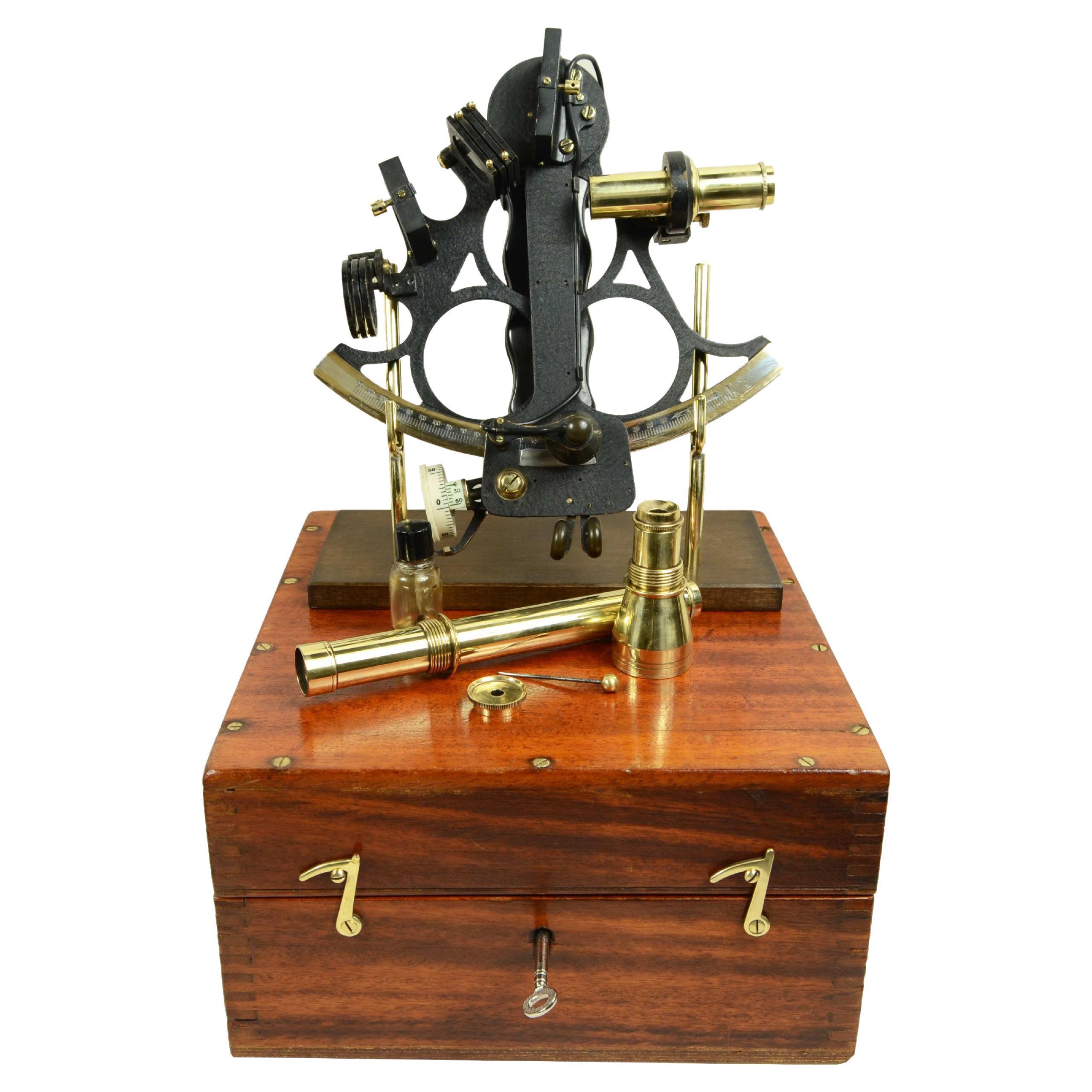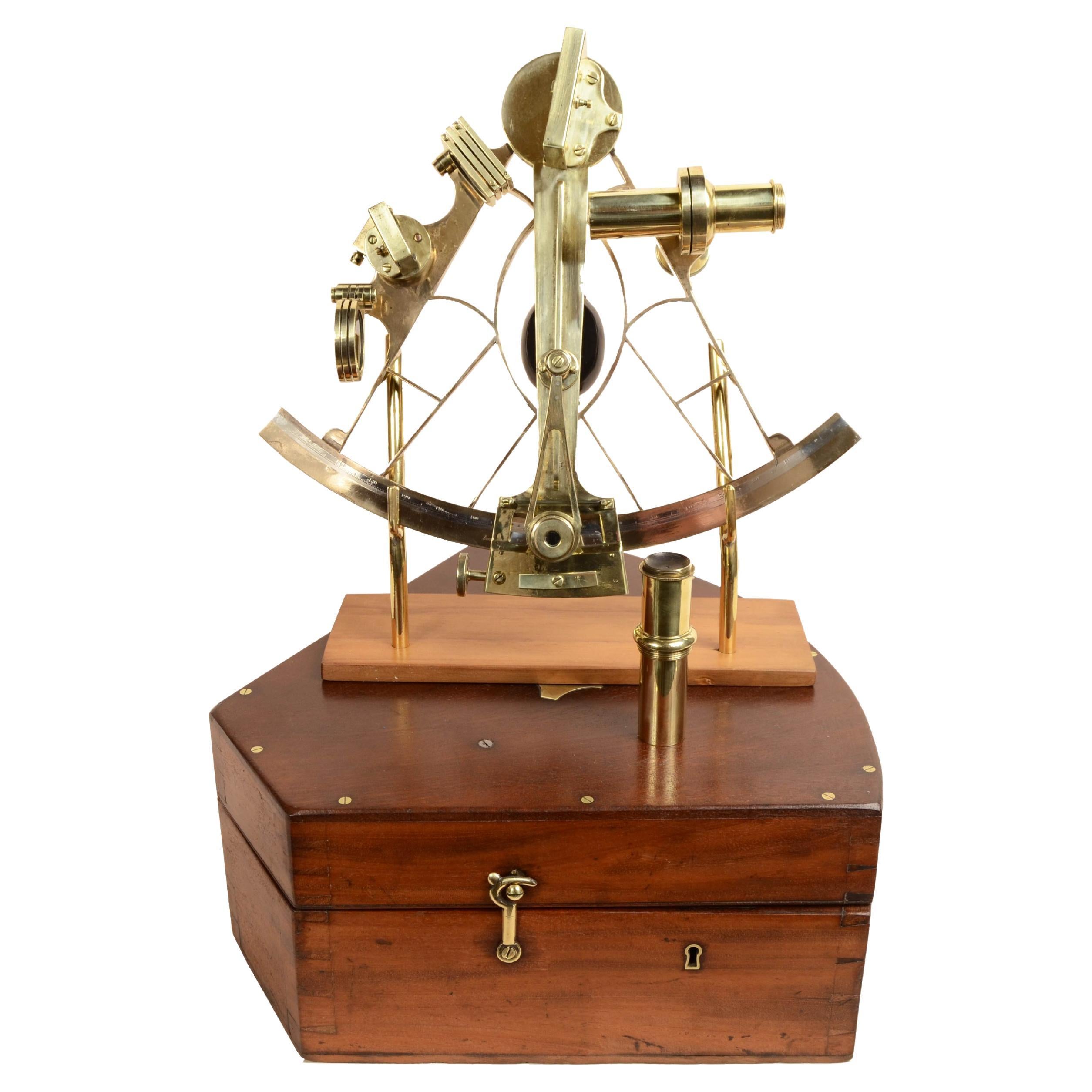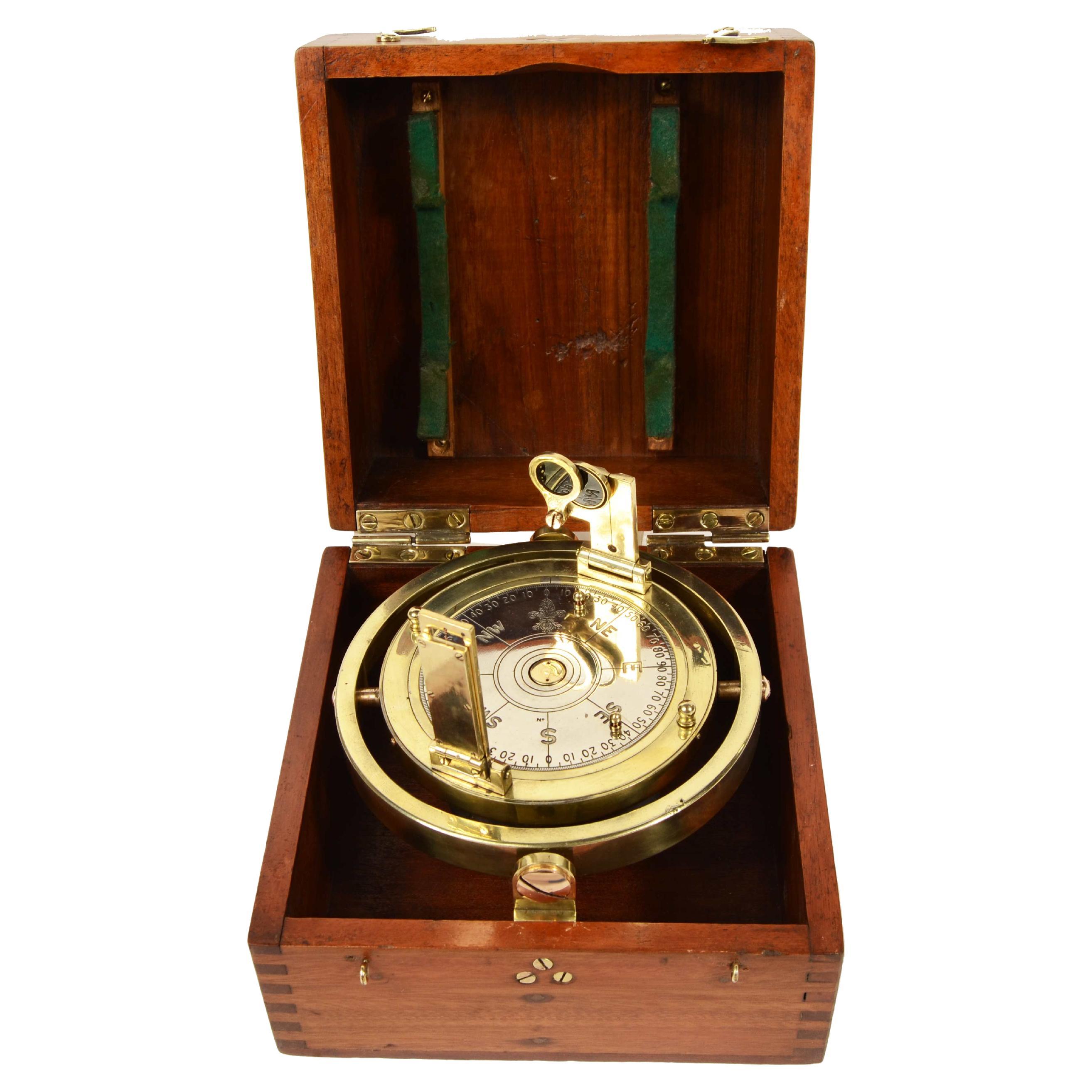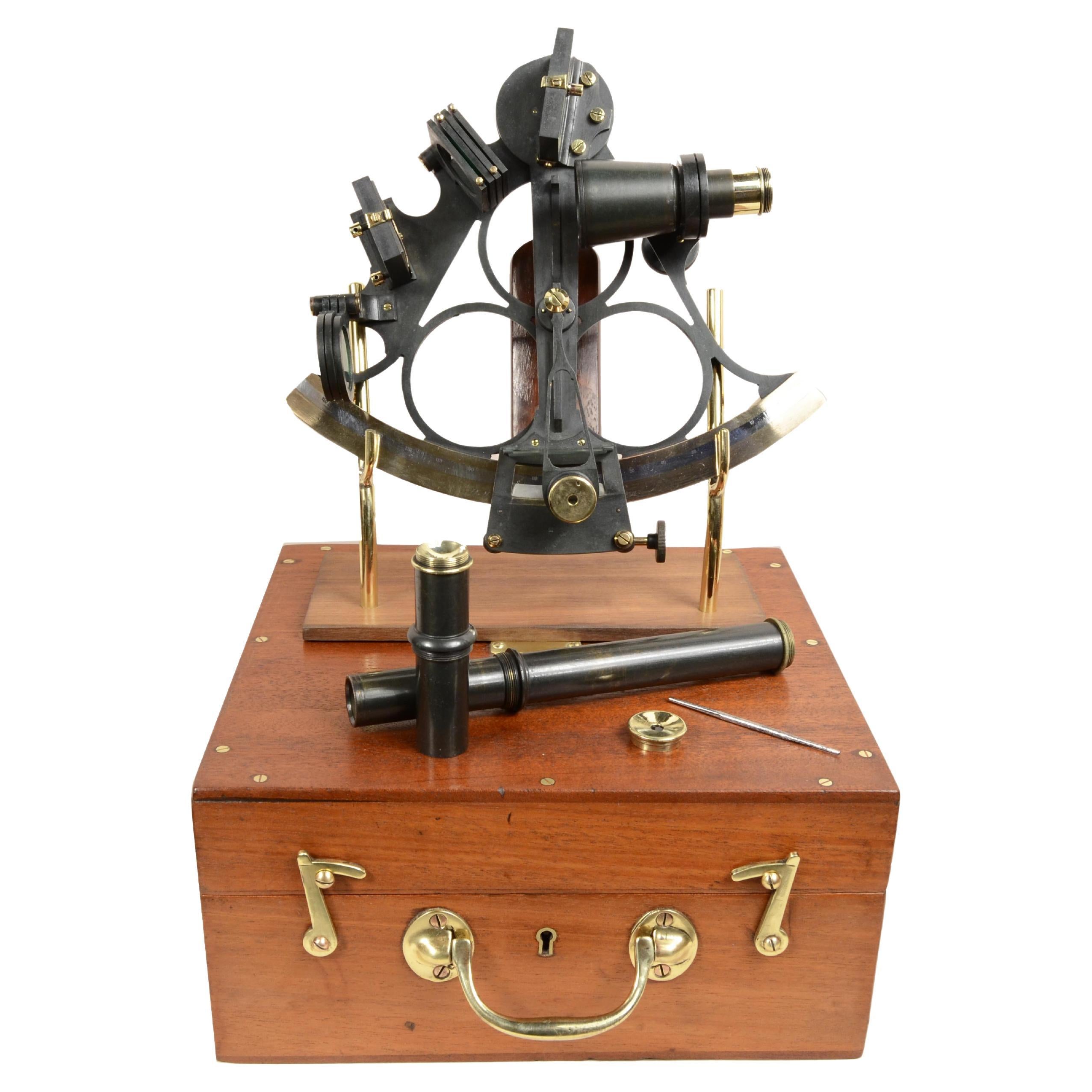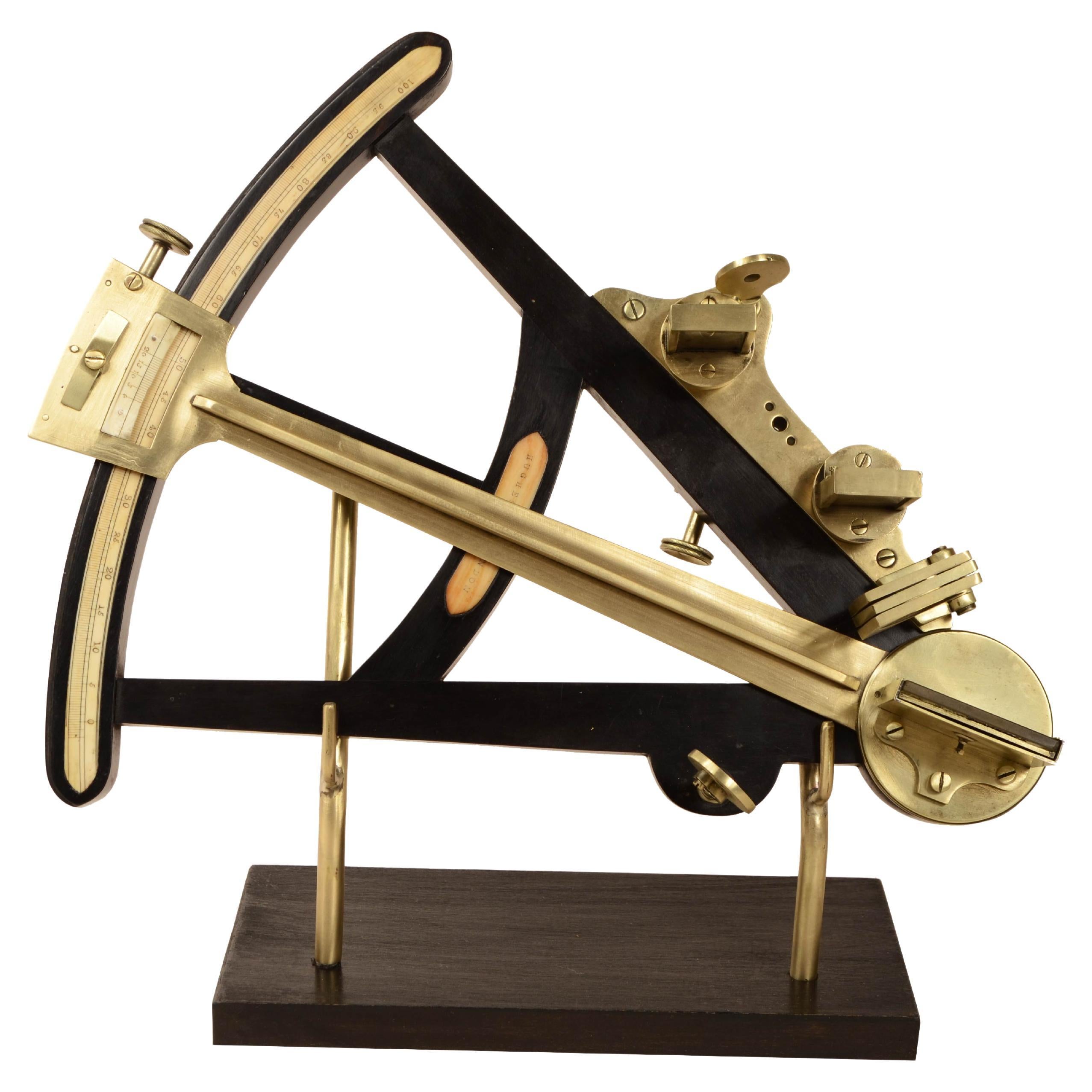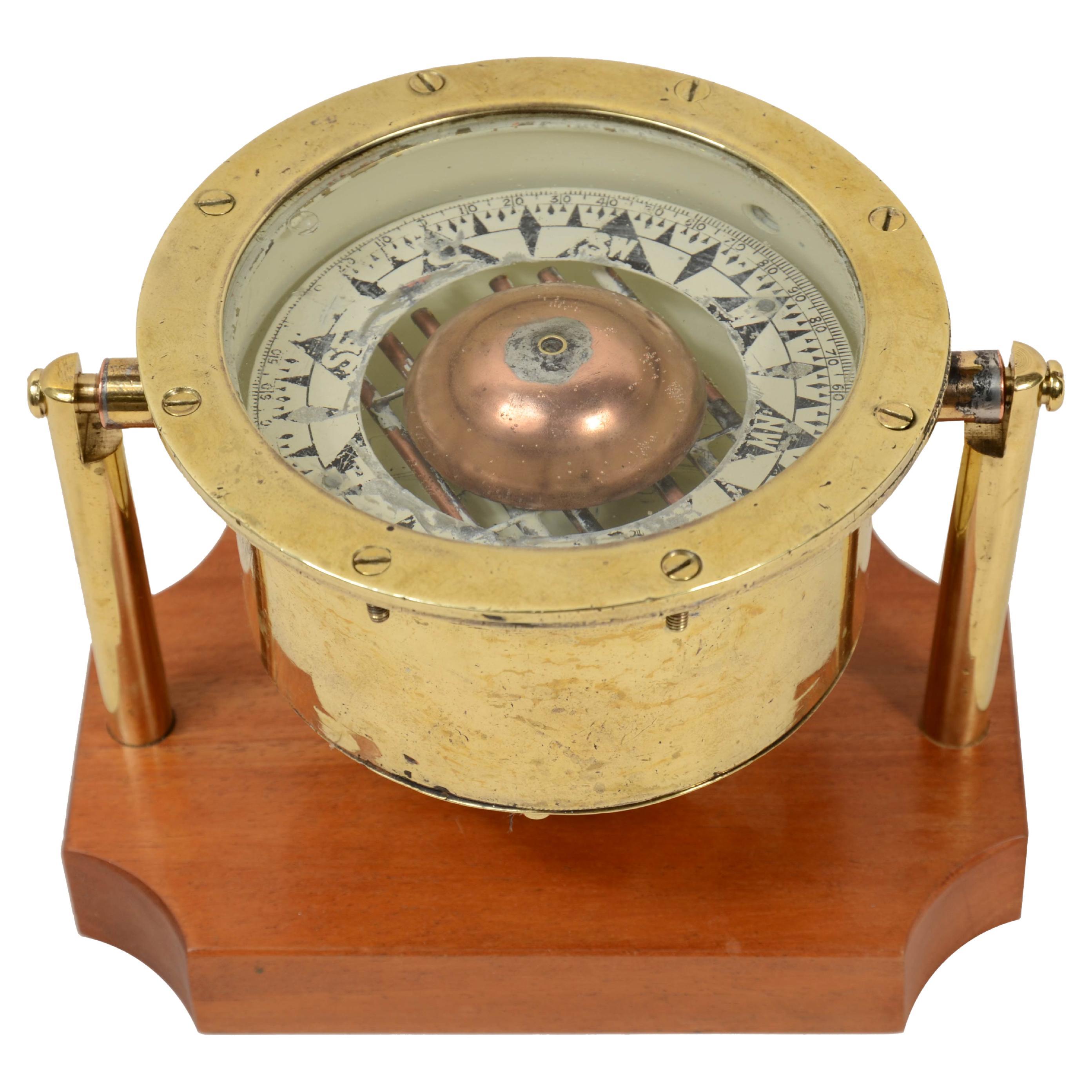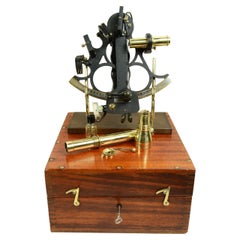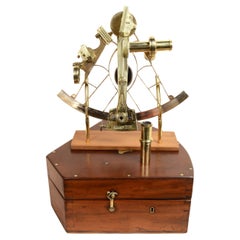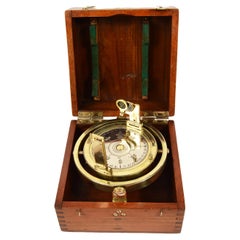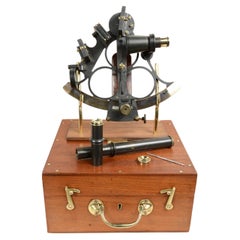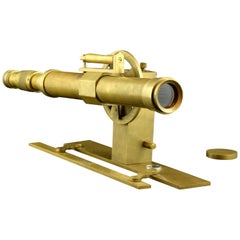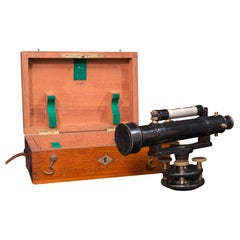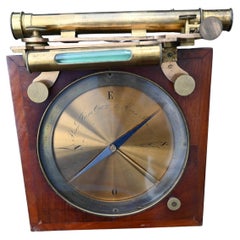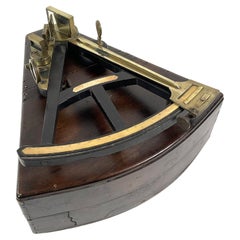Items Similar to Brass sextant signed B. Cooke & Son Hull from the second half of the 19th century
Want more images or videos?
Request additional images or videos from the seller
1 of 21
Brass sextant signed B. Cooke & Son Hull from the second half of the 19th century
$3,527.07
£2,611.09
€2,950
CA$4,880.58
A$5,380.73
CHF 2,815.02
MX$66,011.51
NOK 35,435.55
SEK 33,137.84
DKK 22,471.29
About the Item
Brass sextant signed B. Cooke & Son Hull, from the second half of the 19th century and housed in its original mahogany wood box with brass handle, hinges, and locking hooks, complete with key lock . Silver flap and vernier, ebony handle, 3 colored glasses for fixed mirror and 4 for movable mirror, four telescopes one of which is long, 1 filter, 1 registration key, vernier graduated from 0 to 150°, index and horizon mirror.
A paper label placed inside the box indicates the name of John Bliss nautical instrument repairman in New York.
Conservation status: good, working and complete with base for stand made of custom wood and brass.
Box size cm 25.5x23.5x12.5 - inches 10x9.2x4.8.
The last photo is the gift box.
Barnard Cooke founded his company around 1863, after working 1841 to 1853 with brother Thomas Cooke famous maker of telescopes and watches. B. Cooke & Son has a glorious history as a manufacturer and distributor of nautical instruments.
The sextant is an ancient astronomical instrument used for measuring the height of a star (e.g., the Sun): one places the instrument in a vertical plane and, looking through the aiming device, aims at the horizon line visible through the unsilvered half of the fixed mirror. Moving the alidade, with which the
mirror, it is made so that the light rays coming from the star and subsequently reflected by the moving mirror and the silver half of the fixed mirror are sent back by the latter in the direction of observation: if you look through the aiming device you can see the image of the star, obtained by double reflection, coincide with the horizon line. The height of the astro is expressed by the angle whose value is read on the graduated scale. The filter is used when the star to be looked at is the Sun.
It was Sir Isaac Newton who invented the principle of double reflection in navigation instruments, but this research was never published. Subsequently, two men, independently of each other, discovered the sextant around 1730 : John Hadley (1682-1744), an English mathematician, and Thomas Godfrey, (1704-1749), an American inventor. But it was not until 1758 that Admiral John Campbell carried out a series of offshore trials to test a new method that relied on lunar distance as a means of calculating longitude. This was how the sextant was developed. Initially made of brass, they had scales divided with great precision by mathematicians who made scientific instruments.
About the Seller
5.0
Vetted Professional Seller
Every seller passes strict standards for authenticity and reliability
Established in 1999
1stDibs seller since 2014
398 sales on 1stDibs
Typical response time: 1 hour
- ShippingRetrieving quote...Shipping from: Milan, Italy
- Return Policy
Authenticity Guarantee
In the unlikely event there’s an issue with an item’s authenticity, contact us within 1 year for a full refund. DetailsMoney-Back Guarantee
If your item is not as described, is damaged in transit, or does not arrive, contact us within 7 days for a full refund. Details24-Hour Cancellation
You have a 24-hour grace period in which to reconsider your purchase, with no questions asked.Vetted Professional Sellers
Our world-class sellers must adhere to strict standards for service and quality, maintaining the integrity of our listings.Price-Match Guarantee
If you find that a seller listed the same item for a lower price elsewhere, we’ll match it.Trusted Global Delivery
Our best-in-class carrier network provides specialized shipping options worldwide, including custom delivery.More From This Seller
View AllBrass sextant signed H. Hughes & Son Ltd No. 32890 of the 1930s
Located in Milan, IT
Brass sextant signed H. Hughes & Son Ltd No. 32890 of the 1930s; instrument complete with optics and housed in its original mahogany wood box of with locking hooks and brass handle,...
Category
Vintage 1930s Nautical Objects
Materials
Brass
Brass sextant signed Imray & Son 89 & 102 Minories London mid-19th century
Located in Milan, IT
Brass sextant signed Imray & Son 89 & 102 Minories London, datable to around mid-19th century, instrument housed in its original mahogany box shaped like the instrument with hinges, ...
Category
Antique Mid-19th Century Nautical Objects
Materials
Brass
English Pelorus brass from the second half of the 19th century, on cardan joint
Located in Milan, IT
English Pelorus brass from the second half of the 19th century, mounted on gimbals within its original mahogany wood box with brass hinges and locking hooks.
The instrument has an...
Category
Antique 1870s Nautical Objects
Materials
Brass
Burnished brass sextant D. Mc Lean & Co Lta 113 Frenchurch St. London 1890
Located in Milan, IT
Burnished brass sextant D. Mc Lean & Co Lta 113 Frenchurch St. London, datatable around the end of the 19th century, instrument complete with optics and housed in its original squa...
Category
Antique 1890s Nautical Objects
Materials
Brass
Ebony, brass octant signed Hughes London made around 1830
Located in Milan, IT
Ebony wood, brass and marine ivory octant, scale from 0° to 100°,signed Hughes London made around 1830.
Good condition, complete with custom-made display base made of wood and brass....
Category
Antique 1830s Nautical Objects
Materials
Wood
Bussola a liquido su giunto cardanico e montata su tavola di legno di mogano
Located in Milan, IT
Bussola a liquido su giunto cardanico e montata su tavola di legno di mogano sagomata. Manifattura inglese della fine del XIX sec. La bussola è costituita da un recipiente di forma c...
Category
Antique Late 19th Century Nautical Objects
Materials
Brass
You May Also Like
Decorative Alidade, Metal, 20th Century
Located in Madrid, ES
It has a cover to protect the lens made of the same gold metal in which the rest of the instrument is made. The lines, pure and clean, are the protagonists, and make it a great opti...
Category
20th Century Unknown Other Scientific Instruments
Materials
Metal, Other
Vintage Surveyor's Level, Brass, Scientific Instrument, Engineering, Circa 1950
Located in Hele, Devon, GB
This is a vintage surveyor's level. An English, brass scientific instrument with enamelled finish, dating to the mid 20th century, circa 1950.
Appe...
Category
Mid-20th Century British Scientific Instruments
Materials
Brass
Antique Surveyor's Circumcompendium Signed Brand Frères, 1850-1880
Located in Bilzen, BE
"Antique Surveyor's Circumcompendium Signed Brand Frères, 1850-1880"
Description: Antique Surveying Circumferentor by Brand Frères
Brand Frères, Optic...
Category
Antique Mid-19th Century Belgian Other Scientific Instruments
Materials
Brass
Mid Nineteenth Century Ships Octant
Located in Norwell, MA
Navigators octant with ebony frame, brass arm, filters and peep sight. Bone Vernier scale. Kidney shaped box. Split to box. Circa 1860. This is a good genuine example of an early American marine...
Category
Antique 1860s European Scientific Instruments
Materials
Brass
Nautical marine Sextant by Negretti and Zambra London
Located in Norwich, GB
Nautical Marine Sextant by Negretti and Zambra, London.
Brass and oxidised nautical sextant signed Negretti and Zambra, London.
This fine instrumen...
Category
Antique Early 1900s Nautical Objects
Materials
Brass
Vintage Ships Spotlight on Pedestal
Located in Norwell, MA
Industrial lighting piece of vintage lighting. Ships spotlight which is mounted by an iron yoke onto a brass pedestal. Rewired with an electric socket. ...
Category
Vintage 1940s Nautical Objects
Materials
Aluminum, Brass
